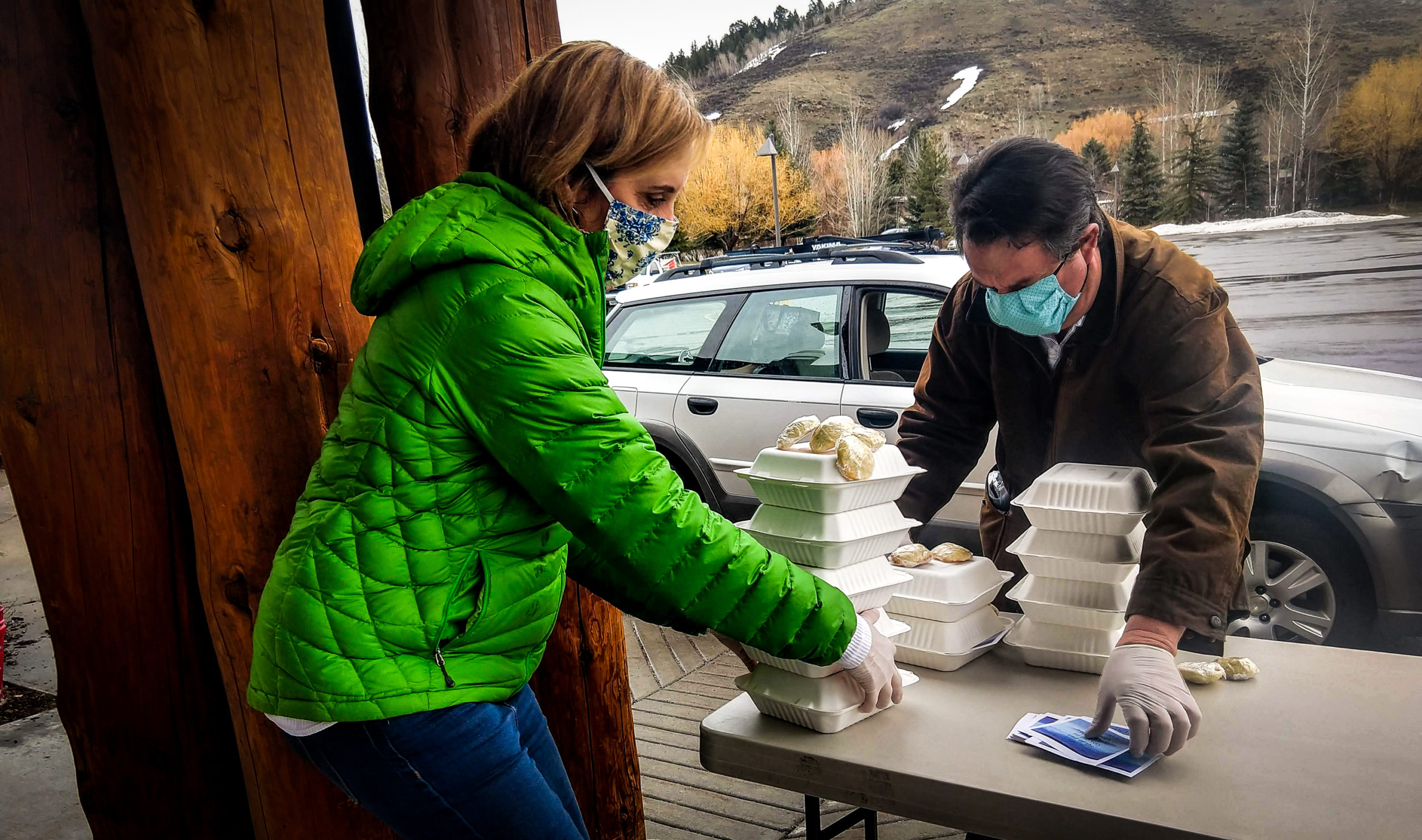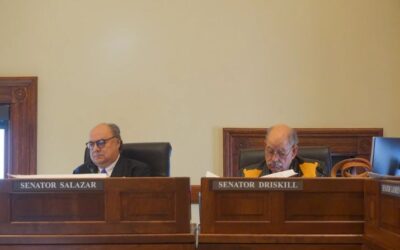The COVID-19 pandemic is shifting the way we view hunger and prompting a robust community response
When COVID-19 first struck Jackson, people rushed grocery stores and stockpiled their pantries. Shelves emptied of basics like flour, pasta, rice, eggs, soup, and frozen veggies.
But what about those who didn’t have adequate nutrition under normal circumstances, much less in a pandemic? How did people without cars load up on piles of groceries?
That is what Christina Kitchen wondered. A nurse practitioner with Gros Ventre OB/GYN, Kitchen immediately thought of patients who might be in need. “I have one patient who is particularly vulnerable,” she said. “She’s frail and has many health issues. She doesn’t have family in town.”
On a recent Thursday evening Kitchen waited in a line of vehicles snaking around the Presbyterian Church parking lot, the garlicky aroma of stuffed shells wafting through the air. The church is providing free takeout dinners every Thursday evening. In quintessential Jackson style, Kitchen was on her e-bike with her toddler in tow and her five-year-old daughter atop her own bike, all three decked out in their puffy jackets. They were picking up meals for Kitchen’s patient as well as a few other people in the patient’s apartment building.
“It’s a great thing for us to get out on the pathways and do something tangible for our community,” Kitchen said.
Tammy Mitchell, associate pastor, said the sense of purpose cannot be overstated. “As a church, we want to love and support our community.”
This kind of spirited generosity is something Teton County Commissioner Natalia Macker calls “awe-inspiring.” From neighborhood food drives to grocery delivery services, a broad network of people is working to make sure no one goes hungry.
“It’s the kind of response that I feel like this community was born to do,” Macker said.
The response wasn’t an accident, but rather the result of a team of local organizations already working on food insecurity. Because of systems and resources in place, they were able to pivot quickly to address the COVID-related need. Community members suddenly facing food insecurity because of job loss or illness have many places to turn for low-cost or no-cost groceries and meals.
The question now is whether shame about food insecurity will prevent some people from reaching out. “The main concern I hear from people who work in food insecurity is how to reduce stigma,” Macker said. “The food is available; people just need to access it.”

Associate Pastor Tammy Mitchell and volunteer Brad Herman stack up free to-go dinners for a long line of cars on a recent Thursday at the Presbyterian Church. The church is serving a few hundred dinners each week. (Emily Cohen/KHOL)
More Folks to Feed
Fighting stigma could mean rethinking the image some people have in their heads about who needs food assistance: Someone facing months of unemployment because of the pandemic. A person who has the money for food but can’t risk exposure at the grocery store.
“This is new territory in terms of our systems because of these changing demographics,” Macker said. “The people working in the food insecurity arena really want to reach everyone.”
Food insecurity is a term that some may not understand. It’s not necessarily about going hungry. The USDA defines food insecurity as an economic and social condition.
“When you cannot consistently provide yourself and your family with adequate, nutritious food” you’re facing food insecurity, said Ali Milburn of Hole Food Rescue. “It means you are nutrient deprived.”
Nutrition is at the heart of HFR’s mission to distribute the valley’s excess food to organizations that serve at-risk residents. Food items include vegetables, fruits, eggs, milk, bread, dried foods, and meat—in other words, whole food with nutritional value.
HFR has been a key player in a task force established by Teton County to address food insecurity. The task force formed three years ago and includes HRF, the Presbyterian Church, the Jackson Cupboard, Teton County School District, Good Samaritan Mission, the Senior Center, One22, and the Wyoming Department of Family Services.
Milburn said that when COVID struck, the task force quickly revamped their website and hit the ground running. Now, as a collective, they are “identifying gaps in the system and figuring out how to address them.”
But reaching all the people who need food is a challenge. For one thing, it’s unclear how many county residents were struggling with food security before the pandemic.
The 2018 Community Health Needs Assessment placed the number of county residents who are food insecure at 10 percent. But that number might have been higher even before COVID. According to a 2018 study by the United Way, 27.8 percent of Teton County households classify as “ALICE,” meaning asset-limited, income-constrained and employed. These are households that earn above the federal poverty level, but not enough to afford a basic household budget.
With the economic fallout from COVID, Milburn said vulnerable workers “have had their legs swept out from under them.”
At the same time, because of the virus, HFR lost access to a number of its usual distribution sites like Munger Mountain Elementary, the Literacy Center, and the Senior Center. Milburn worries that some of those clients may fall through the cracks. She and her staff have scrambled to set up no-cost grocery sites at the Timbers apartment complex on Fridays, and at Blair Place apartments on Wednesdays.
It’s possible that some of HFR’s clients are now going to the Jackson Cupboard. Rachel Daluge, operations director for Jackson Cupboard, said their numbers have doubled. Since mid-March, they’ve served more than 4,200 clients and added additional hours to meet the demand.

Veteran volunteer Cliff Kirkpatrick stocks shelves at the Jackson Cupboard. The food bank has expanded its hours to meet an increasing need for food assistance. (Alex Thompson/for KHOL)
Ordinarily, the Cupboard requires a referral from a local social service agency. During the COVID crisis, that requirement has been waived. This is of particular importance to immigrants who are facing increased scrutiny and limitations by the Trump administration.
One such limitation is Trump’s “public charge rule” which requires green card applicants to make a “declaration of self-sufficiency” that essentially says they won’t use any public assistance.
“It is frightening the bejesus out of people,” Jackson immigration lawyer Elisabeth Trefonas said.
She feels certain the public charge order will keep some people from getting the food they need. “We have had an onslaught of questions: ‘Can I get a COVID test?’ ‘What if I need to stay home because I’m ill?’ ‘If I receive unemployment, will it mean I can’t get my green card?’”
For now, Trefonas advises her clients to go ahead and get the services they need. “With COVID relief, our best guess is that accessing temporary things like food stamps is probably not going to hurt you.”
Trefonas suspects the Trump administration is looking for reasons to deny green cards. If the administration penalizes green card applicants for receiving COVID relief, Trefonas is ready. “I will appeal that shit so fast,” she said.
Her firm received loan funding through the Paycheck Protection Program so her staff is staying on top of such issues, working from home and fielding questions.
People who want to avoid a paper trail associated with seeking assistance can use the HFR no-cost grocery distribution sites. No questions asked, no identification needed. Just come get what you need.
Hidden Hunger
Another option is the Teton County School District’s current COVID response meal program. The district provides free lunches and breakfasts every weekday. Most meals are distributed curbside at Jackson Hole High School, with limited delivery service to various locations. Anyone under 19 can come and no ID is necessary.
The school district’s food service director Wes Clarke said demand is high. He and his team are serving roughly 700 meals per day and as of April 29, they had distributed more than 14,000 breakfasts and lunches.
Food insecurity is not always visibly apparent to others, Clarke stressed. “That’s the big thing that scares me. A kid can skip a meal and you wouldn’t know it unless they told you. They may not have holes in their shoes. It may be a matter of Mom and Dad working two jobs each just to pay the rent and they aren’t home to feed the kids.”
Funded by the USDA, the school lunch program thrives the more people use it. The more meals served, the more reimbursement schools receive. With enough resources at his disposal, Clarke can keep a staff of several people employed and he can ensure a diverse menu with a hot meal option, salads and sandwiches, as well as breakfast items to keep for the next day.
Kids who may have access to food at home are still helping out other kids when they use the free lunch program. “If our numbers get too low, we won’t get enough reimbursement to keep it going,” Clarke said.
Not to mention, pizza! Every Friday, Clarke and his staff distribute 100 Domino’s pizzas, an opportunity for young people to bring home food for their entire family.
Clarke says these days of isolation may also be a reason more people are accessing no-cost food services right now. “It’s been neat to see how many kids are biking in. They are excited. It’s a chance for them to get out of the house and enjoy some fresh air.”
Back at the Presbyterian Church, where demand for its Thursday night meals continues to increase, Pastor Ben Pascal is aware of the many reasons people stop by the church for meals. “Someone asked me how we know if a person really needs a free meal. My answer was, hey, if they come by, they need it. Maybe they are depressed or lonely. Or maybe they just lost their job.”

Stacks of free dinners sit inside the Presbyterian Church to be distributed to motorists, bicyclists and passersby. Volunteers Caroline Mildrum and Patrick Cox helped prepare 180 meals that disappeared in less than an hour. (Emily Cohen/KHOL)
Pascal’s ethos points to the leveling effect of COVID-19. Although vulnerable populations are disproportionately impacted, the virus is affecting all kinds of people in myriad ways, from financial to social to health. No one is immune from the virus, nor from food insecurity.
A New Normal
Laurie Andrews, executive director of the Community Foundation of Jackson Hole, says COVID is forcing some to reckon with uncomfortably novel scenarios. “People have become food insecure that have never been so before in their life. There are folks who are too in danger to leave their homes right now. They are dependent on friends and neighbors. They may be a little surprised by what it’s like to need help.”
Andrews took the helm at the Community Foundation on March 1 and dove straight into the pandemic maelstrom. Like other directors of front-line social service organizations, she’s been in overdrive, albeit from home, working to secure funds, attend meetings, get up to speed on pressing issues, and field phone calls day and night.
The Community Foundation recently provided a grant to launch a sliding-scale program called Quarantine Cuisine. A collaboration between Hole Food Rescue founding board member Cynthia Hogan and co-owner of Fine Dining Restaurant Group Gavin Fine, Quarantine Cuisine delivers meals and groceries to individuals in mandatory or self-imposed quarantine due to confirmed exposure to COVID-19.
“This is dramatic stuff and it happens quickly,” Andrews said of quarantine. “I think we all have a sense of vulnerability.”
In March, the Community Foundation secured $1.4 million within two weeks for a Community Emergency Response Fund. That number has risen to $2.5 million. Some of those funds have gone directly to the county’s main social services organization helping low-income and immigrant families, One22.
It has awarded more than $1.26 million to 1,359 households, with 400 more applications in the pipeline. The awards are intended to help with household expenses for one month.
“People have become food insecure that have never been so before in their life.”
Macker says people are tapping into community resources in a variety of ways, and that food security may fluctuate. “People are making choices about where to spend money. They might apply for a grant from One22 to help pay rent, but still be able to buy their own food for now.”
As the fallout from the pandemic stretches into May and beyond, social service agencies will continue to field requests for assistance. But how they will continue to meet the need depends in part on continued funding.
Andrews has been struck by the generosity of people in the community. She said folks donating to the Community Foundation are deeply concerned about people facing housing and food insecurity.
She hopes they will stay the course.
“The need is going to be there. We need our donors to stick with us.”
Another concern going forward will be continued vigilance on behalf of volunteers. All food volunteers must follow Teton County Health Department’s guidelines, such as frequent hand-washing, staying home if you’re sick, and disinfecting surfaces. At the Presbyterian Church, volunteers must sign a release form stating that they are healthy and not at-risk, and that they agree to follow the guidelines.
In addition to keeping her volunteers and clients safe, Pastor Mitchell is concerned about keeping up with demand. The number of people showing up for free dinners has starkly increased each week. Trying to guess how many meals to prepare in advance has been a challenge. Last week they served 180 dinners and they were all gone in less than an hour.
Mitchell anticipates those numbers to increase as long as the virus is impacting the valley. “Will we see even more people needing meals?” she asked. “Should we add more days for delivery or pick up?”
These same concerns exist on a county-wide level. Macker worries about what happens if peak season isn’t peak season for Jackson’s tourist economy. If seasonal jobs don’t come through, Macker says a key question will be how to meet people in need where they are. “Is that a distribution site? Or is it how they are identified?”
But for now, even with the community’s robust response to food insecurity, Macker is not resting easy.
“I am still asking, who we are missing?” she said. “Who is getting left behind?”
Find local resources for food insecurity here. More information about the “public charge rule” can be found here.






